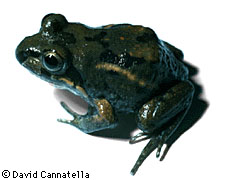Limnodynastinae
David Cannatella- Adelotus
- Heleioporus
- Kyarranus
- Lechriodus
- Limnodynastes
- Megistolotis
- Mixophyes
- Neobatrachus
- Notaden
- Philoria
Introduction
This group is found in Australia, Tasmania and New Guinea. A diverse group of frogs, ranging from 35 to 115 mm in snout-vent length. Many species are burrowers. Most genera have vertical pupils. Breeding males of Limnodynastes beat the egg mass into a foam. In Adelotus the males are large than females, and have a pair of sharp tusks at the tip of the lower jaw. Philoria lay direct-developing eggs in moist tunnels of soil or moss. Some species of Neobatrachus are almost identical to Scaphiopus of North America, both in appearance and in their fossorial habits. Notaden are also burrowers, but have extremely poorly ossified skulls, are mostly brightly colored, and secrete a white sticky skin toxin.
Limnodynastines are generally considered to be part of the family Myobatrachidae, along with the Myobatrachinae. However, Ford and Cannatella (1993) presented evidence indicating that no shared derived characters unite limnodynastines and myobatrachines, and further that their proposed relationship of Sooglossidae with Myobatrachinae would make the family Myobatrachidae paraphyletic. Rather than formally breaking up the Myobatrachidae, Ford and Cannatella (1993) simply dealt with the two subfamilies separately.
Some Miocene and Pleistocene fossils are known.
Discussion of Phylogenetic Relationships
Ford and Cannatella (1993) defined the node-based name Limnodynastinae to be the most recent common ancestor of Adelotus, Heleioporus, Kyarranus, Lechriodus, Limnodynastes, Megistolotis, Mixophys, Neobatrachus, Notaden, and Philoria, and all its descendants. See extensive comments under Myobatrachinae.References
Click here for general list of references
Title Illustrations

Limnodynastes salminii; photo © 1995 David Cannatella
| Copyright |
© 1995 David Cannatella

|
|---|
About This Page
If you are interested in authoring or co-authoring the page for this taxon, or some part of it (even a species), contact David Cannatella.
David Cannatella

University of Texas, Austin, Texas, USA
Correspondence regarding this page should be directed to David Cannatella at
Page copyright © 1995 David Cannatella
 Page: Tree of Life
Limnodynastinae.
Authored by
David Cannatella.
The TEXT of this page is licensed under the
Creative Commons Attribution License - Version 3.0. Note that images and other media
featured on this page are each governed by their own license, and they may or may not be available
for reuse. Click on an image or a media link to access the media data window, which provides the
relevant licensing information. For the general terms and conditions of ToL material reuse and
redistribution, please see the Tree of Life Copyright
Policies.
Page: Tree of Life
Limnodynastinae.
Authored by
David Cannatella.
The TEXT of this page is licensed under the
Creative Commons Attribution License - Version 3.0. Note that images and other media
featured on this page are each governed by their own license, and they may or may not be available
for reuse. Click on an image or a media link to access the media data window, which provides the
relevant licensing information. For the general terms and conditions of ToL material reuse and
redistribution, please see the Tree of Life Copyright
Policies.
Citing this page:
Cannatella, David. 1995. Limnodynastinae. Version 01 January 1995 (under construction). http://tolweb.org/Limnodynastinae/16944/1995.01.01 in The Tree of Life Web Project, http://tolweb.org/








 Go to quick links
Go to quick search
Go to navigation for this section of the ToL site
Go to detailed links for the ToL site
Go to quick links
Go to quick search
Go to navigation for this section of the ToL site
Go to detailed links for the ToL site